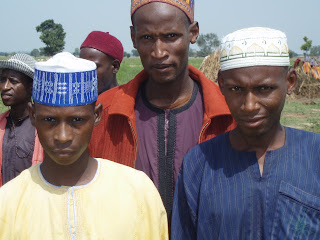The two main tribes in Northern Nigeria are the Hausa and the Fulani. Many of the Fulani still live the traditional life of nomadic herders. They set up temporary villages in places where their cattle can graze and then move on when they need new pastures. We weren't sure at first if we would be able to visit their village because they were still fasting for Ramadan. Our local guide, Danjuma, said that they don't believe in the "radio moon" and they have to see the moon for themselves to end their Ramadan fast. But they agreed to have us visit their village anyway -- no doubt the donation they would receive was an incentive. But it was very interesting to see their way of life.
When they choose their location, they construct a temporary village.
Their huts have quite a tight construction. They are lined with plastic sheets on the inside to give some extra protection against the rain. Their goods are hanging on the hut, inside and out. In the center of each hut a short person could stand upright, but tall people would have to stoop.
Paulette said that there are often conflicts between Fulani and more stationary villagers because the nomadic people sometimes encroach on the land of others. The area where we were is land that is owned by some permanent Fulani people who live there constantly and they keep land for nomadic Fulani to come and graze for a while and also grow crops that the Fulani may use. So there are often different Fulani groups who settle there for a short while before they move on. Their wealth and resource is in their cattle.
There was one Fulani who spoke English to us and explained some of their lifestyle. Most of the Fulani only spoke their tribal language, but there were a few others that also spoke Hausa and Danjuma translated for us. Many seemed very curious about us, adults and children alike, and wanted us to take their picture. These men pointed to me and my camera, obviously wanting me to take their picture, and then they solemnly posed.



The children were especially curious about the white children in our group. When a white Dad wanted to take a picture of his children with some of the Fulani children, there were several of the Fulani children who were very frightened to get close to the white children. It was clear that seeing white people was a new experience for them.



Bushes are the Fulani clothes dryer. There is a good irrigation system in this area and we saw women washing clothes in the irrigation ditch. I imagine that is also where they get their drinking water and also bathe.

There was even a little hut for the chickens.

No Pampers for the nomadic tribe, so babies go bare-bottomed.

Here's a proud father, our English-speaking Fulani villager, who holds the baby and then hands him to his wife, allowing pictures. He obviously has had more contact and comfort with the world outside his Fulani culture. Many of the other adult women in this village were not out where they could interact with the visitors at first, though they came out later for the demonstration they gave us.


I asked about this plate of round brown disks that were sitting on top of the outside of a hut and our English-speaking Fulani explained that it was a bean cake. They mashed the beans and formed them into disks and left them to dry in the sun.











2 comments:
Thank you for your photo-blog of your journey to the northern Nigeia.
I'm part of the diaspora, born abroad and have only ever been to the south (both east and west), never north. At the time I was informed it was a bad idea, by my relatives.
So I find your journey up north to be very interesting.
The Fulani are a very resilient and handsome people.
I hadn't realised how rudimentary the lives of the nomadic Fulani are, each to their own as they say.
The Katsina Durbar looked a lot more interesting than the Kano one.
I think tents would be an improvement from the twigs and plastic they currently use.
Further north (Niger and Algeria) amongst the Tuareg, Berber and other desert dwelling peoples tents are used. They are also more environmentally friendly. (The northern states are suffering creeping desert encroachment.)
Post a Comment